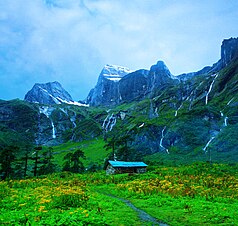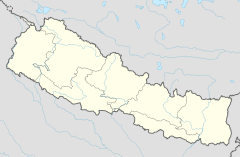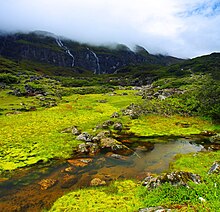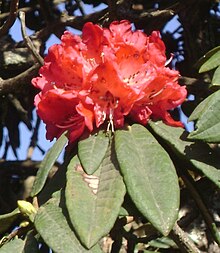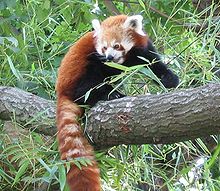Makalu Barun National Park
| Makalu-Barun National Park and Nature Reserve | ||
|---|---|---|
| Landscape in Makalu-Barun National Park | ||
|
|
||
| Location: | Nepal | |
| Specialty: | includes tropical to alpine altitude zones | |
| Surface: | 2330 km² | |
| Founding: | 1992 | |
The Makalu Barun National Park is located in eastern Nepal in the Solukhumbu and Sankhuwasabha districts and was founded in 1992 as an eastern extension of the Sagarmatha National Park under the name Makalu Barun National Park .
It covers an area of 1500 km² and is the only nature reserve in the world with a difference in altitude of more than 8000 m , which includes both tropical forest and icy peaks.
The northern border of the national park is also the border with the Tibet Autonomous Region . At the southern and south-eastern border includes the buffer zone Makalu Barun reserve (Makalu Barun Conservation Area) with a surface area of 830 square kilometers on.
In the national park are the peaks of Makalu , the fifth highest mountain in the world at 8463 m , Chamlang ( 7319 m ), Baruntse ( 7129 m ) and Mera ( 6654 m ). The extent of the protected area from west (27 ° 38 ′ 3 ″ N, 86 ° 46 ′ 48 ″ E) to east (27 ° 46 ′ 46 ″ N, 87 ° 27 ′ E ″) amounts to approximately 66 km, the from north (27 ° 57 ′ 25 ″ N, 87 ° 01 ′ 03 ″ E) to south (27 ° 33 ′ 19 ″ N, 87 ° 06 ′ 55 ″ E) for about 45 km. The difference in altitude between the summit of Makalu and the Arun river valley in the southeast ( 438 m above sea level) is about 8025 m .
history
The establishment of the Makalu-Barun National Park was officially announced in 1991. When it was founded in 1992, it was the sixth national park in Nepal. When the buffer zone was declared in 1999 , the national park was the first to be surrounded by an inhabited nature reserve. More than 32,000 people of different ethnicities live there: Sherpa , Rai , Gurung , Tamang , Magar , Newar , Brahmin and Chhetri .
The entire area is administered by the Department of National Parks and Wildlife Conservation . An innovative nature conservation model is to be implemented here, according to which the local residents in communities and village associations participate in the preservation of their rich cultural tradition, the protected forests and the natural resources on which they depend.
The inaccessible valleys of the Barun , a right tributary of the Arun and its tributary Saldima are in unberührtesten area of the national park, which is therefore the Strict Nature Reserve was appointed (Strict Nature Reserve) - the first in Nepal. Here, natural ecosystems are protected in a pristine state for scientific study and conservation of genetic resources.
climate
The area is located in the eastern climatic zone of the Himalayas , where the monsoon rains begin as early as June and only subside in late September. During these months 70% of the annual precipitation falls of up to 4000 mm. The first harbingers of the monsoons reach the area as early as April.
The temperatures vary greatly because of the enormous difference in altitude. The lower elevations are temperate throughout winter; but in April and May it is already hot and humid.
vegetation
The diverse forest cover typical of the eastern Himalayas in the Makalu-Barun National Park ranges from almost tropical monsoon forest with wing fruit plants at 400 m to subalpine conifers at 4000 m altitude. The appearance of the forest is determined by different variables depending on the altitude, such as the seasonal moisture reserve, temperature and snow cover. The forest areas extend over five bioclimatic altitude zones:
- tropical zone: below 1000 m with stocks of Sal ;
- subtropical zone: 1000–2000 m with stands of schima and pseudo chestnuts ;
- lower and upper temperate zone: 2000–3000 m with mainly broad-leaved, evergreen species such as oak and laurel plants , but also broad-leaved deciduous trees such as maples and magnolias ;
- subalpine zone: 3000–4000 m with stands of Himalayan birch and Himalayan fir .
The forest areas below 2000 m are subsistence - agriculture heavily loaded, so that there remain only a few ecologically significant stocks. Above 2000 m, the forest areas are very extensive because the cool, humid climate does not allow agricultural use there. The subalpine stands along the outer southern slopes to the inner valleys consist almost exclusively of conifers, predominantly junipers and firs . The alpine zone over 4000 m is overgrown with junipers and rhododendrons and consists of pasture land.
More than 3100 types of flowering plants have been identified, including rhododendrons (25 types), primroses (48 types), orchids (47 types), bamboo (19 types), oaks (15 types), 86 types of fodder trees and 67 types of medicinal valuable plants.
fauna
The area is a habitat for a wide variety of animals. Ornithologists have identified 440 species of birds, at least 16 of which are extremely rare. There are also 315 types of butterflies , 78 types of fish , 43 types of reptiles , 25 types of mammals and 16 types of amphibians .
To the living in the national park mammals include snow leopards , Indian leopards , clouded leopards , red pandas , spotted linsang , Asiatic black bears , jackals , Himalayan wolves, Indian langurs , Assam macaques , Himalayan Tahr , barking deer , musk deer , Himalayan serow , wild boar , flying squirrels , Marmots and otters . In May 2009, zoologists were able to capture an Asiatic golden cat at an altitude of over 2500 m for the first time with the help of a camera trap .
tourism
The best times to travel are from October to November and from March to April, when the paths and passes are clear of snow. During these months there are daily flights from Kathmandu to Tumlingtar , from where the national park is within walking distance.
Individual evidence
- ^ A b Carpenter, C., Zomer, R. (1996) Forest ecology of the Makalu-Barun National Park and Conservation Area, Nepal . Mountain Research and Development, 16 (2), 1996: pp. 135-148
- ↑ Mehta, J., Kellert, S. (1998) Local attitudes toward community-based conservation policy and programs in Nepal: a case study in the Makalu-Barun Conservation Area . Environmental Conservation 25 (4): 320-333.
- ↑ Shrestha, TB, Sakya R., Nepali, HS (1990) Scientific Report on field survey of 1989: General and Phyto-ecology Working paper No. 8 , Makalu-Barun Conservation Project, Kathmandu, Nepal.
- ↑ a b Jha, SG (2003) Linkages between biological and cultural diversity for participatory management: Nepal's experiences with Makalu-Barun National Park and buffer zone . Journal of the National Science Foundation of Sri Lanka 31 (1 & 2): 41–56 full text as PDF ( memento of the original from July 22, 2011 in the Internet Archive ) Info: The archive link was inserted automatically and has not yet been checked. Please check the original and archive link according to the instructions and then remove this notice.
- ↑ Ghimirey, Y., Pal, P. (2009) First camera trap image of Asiatic golden cat in Nepal . Cat News 51: 17 full text as PDF ( memento of the original from July 26, 2011 in the Internet Archive ) Info: The archive link was inserted automatically and has not yet been checked. Please check the original and archive link according to the instructions and then remove this notice.
